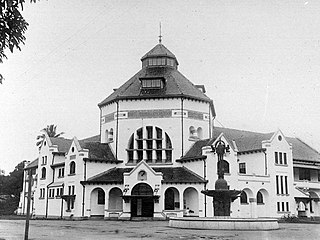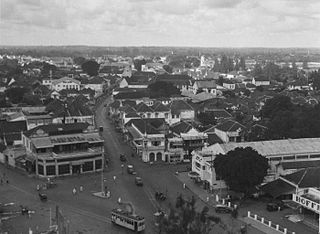Old Medan City Hall is a building located on Jalan Balai Kota (City Hall Street), Medan, North Sumatra.
Old Medan City Hall is a building located on Jalan Balai Kota (City Hall Street), Medan, North Sumatra.
The Old Medan City Hall was built in 1908 during the Dutch colonial period. The building was designed by C. Boon, an architect for the Deli Group. [1]
The City Hall is kilometre zero in Medan, and was originally built for the Bank of Java (now Bank Indonesia), but was instead purchased by the City Council of Medan. [2] Its bell was donated in 1913 from the Tjong A Fie Mansion.
Medan City Hall is now owned and managed by the Grand CityHall Hotel hotel-office-retail complex, situated just behind it.

Medan is the capital and largest city of the Indonesian province of North Sumatra. A regional hub and financial centre of Sumatra. According to the National Development Planning Agency, Medan is one of the four main central cities of Indonesia, alongside Jakarta, Surabaya, and Makassar. As of the 2020 Census, Medan has a population of 2,435,252 within its city limits, and over 3.4 million in its built-up urban area, making it the fourth largest urban area in Indonesia. The Medan metropolitan area—which includes neighbouring Binjai, Deli Serdang Regency, and a part of Karo Regency—is the largest metropolitan area outside of Java, with 4,744,323 residents counted in the 2020 Census. Medan is a multicultural metropolis and a busy trading city bordered by the Strait of Malacca, making it one of the major economic cities in Indonesia. A gateway to the western part of Indonesia, Medan is supported by the Port of Belawan and Kualanamu International Airport, both of which are connected to the city centre via toll roads and railways.

Tegal is a city in the northwest part of Central Java of Indonesia. It is situated on the north coast of Central Java, about 175 kilometres (109 mi) from Semarang, the capital of the province. It had a population of 239,599 at the 2010 Census and 276,734 at the 2015 Census. Its built-up area made up of Tegal Municipality and 12 districts spread over Tegal and Brebes Regencies was home to 1,366,858 inhabitants as of 2010 census. It is administratively separate from Tegal Regency, which borders it to the south and east; Brebes Regency borders it to the west.

Bank Indonesia (BI) is the central bank of the Republic of Indonesia. It replaced in 1953 the Bank of Java, which had been created in 1828 to serve the financial needs of the Dutch East Indies.
Bandung is a city in the western part of Java island in Indonesia. Beside its own city administration, Bandung also serves as the capital of the West Java province.

The architecture of Indonesia reflects the diversity of cultural, historical and geographic influences that have shaped Indonesia as a whole. Invaders, colonizers, missionaries, merchants and traders brought cultural changes that had a profound effect on building styles and techniques.

Jakarta is Indonesia's capital and largest city. Located on an estuary of the Ciliwung River, on the northwestern part of Java, the area has long sustained human settlement. Historical evidence from Jakarta dates back to the 4th century CE, when it was a Hindu settlement and port. The city has been sequentially claimed by the Indianized kingdom of Tarumanegara, the Hindu Kingdom of Sunda, the Muslim Sultanate of Banten, and by Dutch, Japanese and Indonesian administrations. The Dutch East Indies built up the area before it was taken during World War II by the Empire of Japan and finally became independent as part of Indonesia.

Merdeka Square is a large square located in the center of Jakarta, Indonesia. Merdeka is the Indonesian word for freedom or independence. Measuring approximately one square kilometer in area, if the surrounding fields within the Merdeka Square are included, it is considered one of the largest squares in the world. At 75 hectares, it is over five times the size of Tiananmen Square, and 12 times the size of Place de la Concorde.

Dutch colonial architecture refers to the various style of Dutch architecture built across the Dutch Empire. Though most of the buildings were designed by Dutch architects and dictated by Western architectural styles, even the most ardent style-purists among architects could not escape the forces of context and culture. Dutch colonial architecture often is a result of climatological adaptions or the use of local building materials - and more importantly, the rich and diverse cultural contexts. In this hybridity lies the quality of these buildings. Architecture shows that the strict racial taxonomy of a colonial system could not be maintained.

Dutch colonial architecture in Indonesia were built across the archipelago that once was known as Dutch East Indies. Most of the better and permanent colonial era structures are located in Java and Sumatra, which were economically considered more important during the Dutch imperial period. As a result, there are large number of colonial buildings concentrated in its cities. Plenty of old Dutch East India Company (VOC)-era forts and warehouses are also scattered throughout the archipelago, particularly around Maluku Islands and Sulawesi. There are three Dutch colonial architectural styles:

New Indies Style is a modern architectural style used in the Dutch East Indies between the late 19th-century through pre-World War II 20th-century. New Indies Style is basically early modern (western) architecture, which applies local architectural elements such as wide eaves or prominent roof as an attempt to conform with the tropical climate of Indonesia.

Kesawan is a district in West Medan, Medan, Indonesia. This region is filled with historic buildings along Jalan Ahmad Yani, the oldest street in Medan. Kesawan Square was developed by Iskandar ST.

The Medan Post and Telegraph Office is a historic building in Medan, Indonesia. It was designed by Ir. S. Snuyf from Burgelijke Openbare Werken (BOW) and opened in 1911. Located in downtown Medan, several other important colonial era buildings are located nearby including Old City Hall Medan, Inna Dharma Deli Hotel, Grand Mosque, Maimoon Palace, Immanuel Church, Tjong A Fie Mansion and Sri Mariamman Temple. The post office remains in operation and includes a stamp collection exhibit. Snuyf also designed Palembang City Hall. A fountain in front of the post office was a tribute to Jacob Nienhuys.

The old Governor's house in Medan is a historic mansion that was used by the resident during the Dutch East Indies and remains an example of colonial architecture in Medan, East Sumatra, Indonesia.

Colonial architecture in Surabaya includes the legacy of neoclassical architecture and Dutch architecture built during the Dutch East Indies era. The old city in Surabaya is a tourist attraction but faces problems with the deterioration of older buildings. It includes Dutch architecture, has an Arab quarter and areas exhibiting Chinese influence. Jembatan Merah is an area known for its Dutch architecture.

NV Hotel Mijn de Boer is a Dutch colonial style hotel located on the Cremerweg, Medan, Dutch East Indies, current-day Indonesia. The hotel was built in 1898 by Workum native and Dutch businessman Aeint Herman de Boer.

Hotel der Nederlanden was a historic hotel in Jakarta, Indonesia. Hotel der Nederlanden was one of the three grand hotels in Batavia during the last period of the colonial rule, the other being Hotel des Indes and the Grand Hotel Java. The hotel had operated for more than a century, after which it was demolished in 1969 and was replaced with the Bina Graha presidential office.

Johannes Martinus (Han) Groenewegen was a Dutch architect who was active in the Netherlands and the Dutch East Indies, and subsequently, Indonesia from the 1920s to the 1960s.

Jakarta City Hall is the seat of the Jakarta City government. The complex contains the official office of the governor and the vice governor of Jakarta, and the main administrative office. Jakarta City Hall is located south of Merdeka Square.